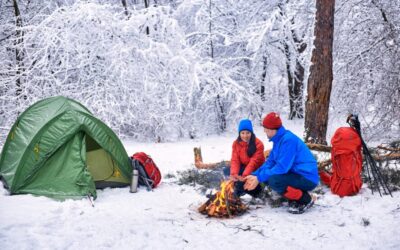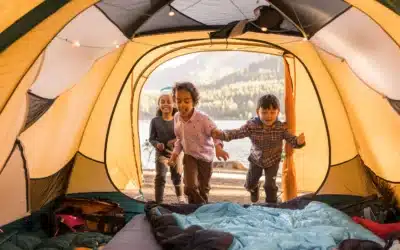As the sun dips below the horizon, casting a warm, golden glow over your campsite, you can’t help but feel a profound connection to nature. Camping is more than just a pastime; it’s an opportunity to bond with the wild and untamed world. However, with this privilege comes a responsibility — tread lightly and leave no trace.
Developed by the Leave No Trace organization, the seven principles of Leave No Trace provide a moral compass for campers by guiding them on a path of ethical and sustainable outdoor exploration. It’s important to camp responsibly, and learn how to camp clean and minimize the impact on nature/
Plan Ahead and Prepare

Ready for your zero-trace camping trip? It starts by planning.
- Research your destination. Start by researching the area where you plan to camp. Look for up-to-date information on park websites. You can even seek advice from friends who are seasoned travelers. One of the most essential information pieces that you’ll need is regarding the rules, regulations, and special considerations governing that given area. For example, some parks have restrictions on campfires or specific wildlife concerns.
- Check weather conditions. Always check the weather forecast for your camping dates. Knowing the expected weather can help you pack appropriate clothing and gear, ensuring safety and comfort during your trip. But be prepared for the unexpected. Don’t ignore that 10% chance of rain — you don’t want to be caught in an unrelenting rainstorm.
- Make a checklist of necessary items. Make a checklist of items such as emergency supplies, food supplies, clothing, devices, and portable restroom solutions. Nearby convenience stores will most likely be many miles away. Once you’re out there in the woods, it’ll be too late to turn back. Go through your list and make sure every item has been accounted for. Don’t forget to add – leave no trace.
Travel and Camp on Durable Surfaces

We get it. The adventurer in you is eager to explore every and all possible paths. But use existing trails and designated campsites whenever possible. Avoid trampling on fragile vegetation — it can take years for some plant species to recover.
When it comes to pitching your tent, opt for durable surfaces like established campgrounds. Utilizing these sites not only ensures minimal impact upon your natural surroundings, but it means you are also following expected camping regulations. The plus side is that you may have other fellow campers as neighbors!
Leave What You Find

Another core principle is to leave what you find. When you’re surrounded by so much beauty, it may be tempting to pick at a wildflower or two or glide your hands over ancient rocks and minerals. However, picking flowers can disrupt the pollination of plant populations, and touching rocks can disturb the delicate balance of microorganisms on the surface of those rocks.
When it comes to interacting with the natural environment, small actions can cause chain reactions. Remember to leave what you find behind and capture the moment in a different way.
Does this mean you won’t be able to make the most of your camping trip? Not at all. Here are some creative ways you can appreciate nature’s beauty without disturbing it:
- Photography: Photography is an excellent way to capture the essence of the wilderness. You can experiment with different angles, lighting, and compositions to convey the beauty and grandeur of nature. Consider long-exposure shots of streaming water or starry night skies for a unique perspective.
- Sketching/drawing: You can capture scenic landscapes, intricate plant details, or wildlife in their natural habitats through your drawings. Sketching not only allows you to appreciate nature, it encourages you to study it closely. Don’t worry about having the best art skills. You don’t have to be a professional artist to enjoy the benefits of this hobby.
- Field notes/journaling: Bring a notepad and record your camping experiences. You can document your observations, such as the color of the sky at sunrise and the sounds of the forest at night.
Minimize Campfire Impact

While campfires can be enjoyable, they can also damage the environment. Fires can disrupt ecosystems by destroying vegetation, altering soil composition, and affecting wildlife habitats. In addition, uncontrolled fires can pose serious safety risks to campers and their surroundings, especially in windy or dry conditions. By minimizing campfires, you are reducing the likelihood of wildfires and accidents.
Here’s what you can do to minimize risks associated with campfires. Use a camp stove for cooking — it’s more efficient and this method preserves local wood resources. If you plan on starting a fire yourself, ensure it’s within your camping site’s regulations. Use established fire rings, keep the fire small, and use only small sticks and twigs found on the ground. You can also bring your own firewood, which is prepackaged and sold in popular grocery stores. Always check the weather report before starting a fire, and be extra cautious during windy conditions.
Respect Wildlife

Wildlife plays a crucial role in maintaining the diversity of the ecosystem. Each species contributes to the balance of an ecosystem, and the loss of one can have far-reaching consequences. Hence, it’s essential to observe wildlife from a distance. Bring a set of binoculars or a camera with a zoom lens that allows you to capture close-up views while keeping a safe distance.
In addition, avoid feeding animals or leaving food behind for them to scavenge. Human food often contains preservatives and additional ingredients that harm their digestive systems. Even if you were to feed them food that is complementary to their natural diet (like raw meat or berries), the very act of feeding them will end up disrupting their natural behaviors.
Be Considerate of Others

When we venture into the great outdoors, it’s essential to remember that we’re sharing these spaces with fellow adventurers and nature enthusiasts. Be considerate of others — the first step of which is to respect personal space. Campsites and trails can get crowded, especially in popular areas. Respecting the personal space of others means setting up camp at a reasonable distance and yielding to those moving faster on a trail.
Additionally, be mindful of noise levels. Many people go on camping trips to seek out the tranquility of nature. Practicing consideration for others in the wilderness creates a positive and harmonious outdoor experience for everyone, fostering a sense of community and respect for the environment.
Dispose of Waste Properly

Proper waste disposal is crucial to preserving the natural environment. When we dispose of waste properly, we safeguard the natural beauty of the environment, protect wildlife, and ensure that future generations can enjoy the pristine wilderness too. By following responsible waste disposal practices, we contribute to preserving nature and demonstrate our commitment to leaving nature unspoiled for all to enjoy.
The first step to properly disposing of waste occurs before you even set foot in your car. Take the time to minimize packaging before you head to your camping trip. Remove excess packaging from food items and transfer them into reusable containers. Being mindful of packaging reduces the amount of waste you generate and also lightens your load.
If you do produce trash during your camping trip, make sure to store it in a secure, airtight container to prevent wildlife from getting to it. When you return home to your city, dispose of trash into your own garbage bins.
Last but not least, human waste disposal is a critical aspect of the Leave No Trace principles. However, not all camping sites have designated restroom facilities.
Fortunately, many portable toilets, otherwise known as wag bags, are available. Wag bags are easy to use and provide a convenient and hygienic solution for going to the restroom when no physical restrooms are available. At Cleanwaste, we provide state-of-the-art wag bags that are safe, sanitary, and environmentally friendly.
By following the Leave No Trace principles for your camping trip, you’ll immerse yourself in nature’s beauty without causing harm to your environment. Remember, the Leave No Trace movement is not just about adhering to sustainability guidelines, but it’s also about finding joy and wonder in appreciating the outdoors in its pristine state. It’s about becoming a steward of the environment, leaving behind only footprints, and taking with you a deeper understanding and appreciation of the natural world. And when nature calls and you have to go (no pun intended!), we’ve got you covered. Shop all of our portable restroom solutions here.




